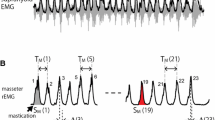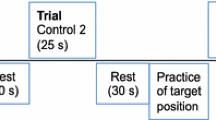Abstract
During chewing, a small part of the observed muscle activity is needed for the basic open-close movements of the mandible, and additional muscle activity (AMA) is needed to overcome the resistance of the food. The AMA consists of two contributions: a large peripherally induced contribution, starting after food contact and a small anticipating contribution, starting before food contact. We investigated whether the latencies of these contributions depend on the expected or actual bolus size.
Subjects made rhythmic open-close movements near their natural chewing frequency controlled by a metronome. This frequency was determined while the subjects were chewing gum. Food resistance was simulated by an external force, acting on the jaw in a downward direction during part of the closing movement. Bolus size was simulated by the jaw gape at which the force started. Jaw movement and surface EMG of the masseter and anterior temporal muscles on both sides and the suprahyoid muscles were recorded during experiments in which the jaw gape at which the force started was varied. The peripherally induced contribution to the AMA started about 20 ms after the onset of the force, irrespective of the jaw gape at which the force started. It is concluded thatthe onset of this contribution depends solely on food contact in the actual cycle. The function of the observed mechanism for jaw elevator muscle control may be to enable a highly automatic control of the muscle activity required to overcome the resistance of food of different hardness and different size.
The onset of the anticipating contribution to the AMA showed neither a relationship with the actual jaw gape at which force onset occurred nor with the expected jaw gape of force onset. It is suggested that the onset of the anticipating AMA is related to the jaw gape at the onset of closing. The function of this contribution may be the regulation of the mechanical response of the jaw after an expected disturbance of the closing movement by food contact, by tuning the muscle stiffness to the expected hardness of the food.
Similar content being viewed by others
References
Ahlgren J (1966) Mechanism of mastication. Acta Odontol Scand 24:[Suppl44,]: 1–109
Ahlgren J, Öwall B (1970) Muscular activity and chewing force: A polygraphic study of human mandibular movements. Arch Oral Biol 15:271–280
Chan CWY, Melvill Jones G, Kearney RE, Watt DGD (1979a) The ‘late’ electromyographic response to limb displacement in man. I. Evidence for supraspinal contribution. Electroencephalogr Clin Neurophysiol 46:173–181
Chan CWY, Melvill Jones G, Catchlove RFH (1979b) The ‘late’ electromyographic response to limb displacement in man.II.Sensory origin. Electroencephalogr Clin Neurophysiol 46:182–188
Cooke JD (1980) The role of stretch reflexes during active movements. Brain Res 181:493–497
Davidson RM, Mohl ND (1987) Sensory and motor integration during mandibular function. Dent Clin North Am 31:615–626
Dellow PG, Lund JP (1971) Evidence for central timing of rhythmical mastication. J Physiol (Lond) 215:1–13
Diaz-Tay J, Jayasinghe N, Lucas PW, McCallum JC, Jones JT (1991) Association between surface electromyography of human jaw-closing muscle and quantified food breakdown. Arch Oral Biol 36:893–898
Enomoto S, Schwartz G, Lund JP (1987) The effects of cortical ablation on mastication in the rabbit. Neurosci Lett 82:162–166
Erkelens CJ, Bosman F (1985) Influences of periodontal and mandibular-joint receptors on reflex sensitivity of human jaw closing muscles. Arch Oral Biol 30:545–550
Funakoshi M, Amano N (1974) Periodontal jaw muscle reflexes in the albino rat. J Dent Res 53:598–605
Goldberg LJ, Chandler SH (1990) Central mechanisms of rhythmical trigeminal activity. In: Taylor A (eds) Neurophysiology of the jaws and teeth. Macmillan, Hong Kong, pp 268–293
Goodwin GM, Luschei ES (1974) Effects of destroying spindle afferents from jaw muscles on mastication in monkeys. J Neurophysiol 37:967–981
Hannam AG (1972) Effect of voluntary contraction of the masseter and other muscles upon the masseteric reflex in man. J Neurol Neurosurg Psychiatry 35:66–71
Hannam AG, Inkster WC, Scott JD (1975) Peak electromyographic activity and jaw-closing force in man. J Dent Res 54:694
Horio T, Kawamura Y (1989) Effects of texture of food on chewing patterns in the human subject. J Oral Rehab 16:177–183
Koolstra JH, van Eijden TMGJ, Weijs WA, Naeije MA (1988) Three-dimensional mathematical model of the human masticatory system predicting maximum possible bite forces. J Biomech 7:563–576
Lamarre Y, Lund JP (1975) Load compensation in human masseter muscles. J Physiol (Lond) 253:21–35
Lavigne G, Kim JS, Valiquette C, Lund JP (1987) Evidence that periodontal pressoreceptors provide positive feedback to jaw closing muscles during mastication. J Neurophysiol 58:342–358
Lobbezoo F, van der Glas HW, van der Bilt A, Bosman F (1993a) Gain and threshold of the jaw-jerk reflex in man during isometric contraction. Exp Brain Res 93:129–138
Lobbezoo F, van der Glas HW, van der Bilt A, Bosman F (1993b) Jaw-jerk reflex activity in relation to various clenching tasks in man. Exp Brain Res 93:139–147
Lund JP (1991) Mastication and its control by the brain stem. Critical Reviews in Oral Biology and Medicine 2:33–64
Lund JP, Olsson KA (1983) The importance of reflexes and their control during jaw movement. Trends Neurosci 6:458–463
Lund JP, Lamarre Y, Lavigne G, Duquet G (1983) Human jaw reflexes. In: Desmedt JE (eds) Advances in neurology. Raven Press, New York, pp 739–755
Luschei ES, Goldberg LJ (1981) Neural mechanisms of mandibular control: mastication and voluntary biting. In: Brooks VB (eds) Handbook of physiology, Sect 1, The nervous system vol 2, Motor Control. American Physiological Society, Washington DC, pp 1237–1274
Marsden CD, Rothwell JC, Day BL (1983) Long-latency automatic responses to muscle stretch in man: origin and function. Adv Neurol 39:509–539
Miles TS, Madigan ML (1983) Programming of antagonist muscle stiffness during masticatory muscle unloading in man. Arch Oral Biol 28:947–951
Morimoto T, Inoue T, Masuda Y, Nagashima T (1989) Sensory components facilitating jaw-closing muscle activities in the rabbit. Exp Brain Res 76:424–440
Nozaki S, Iriki A, Nakamura Y (1986) Localization of central rhythm generator involved in cortically induced rhythmical masticatory jaw-opening movement in the guinea pig. J Neurophysiol 55:806–825
Otten E (1991) The control of movements and forces during chewing. In: Vincent JFV, Lillford PJ (eds) Feeding and the texture of food, Cambridge University Press, Cambridge, pp 123–141
Ottenhoff FAM, van der Bilt A, van der Glas HW, Bosman F (1991a) Peripheral induction in generating elevator muscle activity during simulated chewing in man. In: Anderson PA, Hobart DJ, Danoff JV (eds) Electromyographical kinesiology, Elsevier, Amsterdam New York, pp 99–102
Ottenhoff FAM, van der Bilt A, van der Glas HW, Bosman F (1991b) Peripheral control of elevator muscle activity during simulated chewing in man. Soc Neurosci Abstr 17:1225
Ottenhoff FAM, van der Bilt A, van der Glas HW, Bosman F (1992a) Peripherally induced and anticipating elevator muscle activity during simulated chewing in humans. J Neurophysiol 67:75–83
Ottenhoff FAM, van der Bilt A, van der Glas HW, Bosman F (1992b) Control of elevator muscle activity during simulated chewing with varying food resistance in humans. J Neurophysiol 68:933–944
Ottenhoff FAM, van der Bilt A, van der Glas HW, Bosman F (1993) A computer controlled experimental set-up enabling the quantification of motor performance in man applied to mastication. J Oral Rehab (in press)
Plesh O, Bishop B, McCall W (1986) Effect of gum hardness on chewing pattern. Exp Neurol 92:502–512
Sumino R (1976) Mechanisms of responses of masseteric motoneurons to intra-oral stimulation in the cat. In: Anderson DJ, Matthews B (eds) Mastication, Wright, Bristol, pp 184–197
Thexton AJ (1973) Some aspects of neurophysiology of dental interest. I. Theories of oral function. J Dent 2:49–54
van der Bilt A, Ottenhoff FAM, van der Glas HW, Bosman F (1991a) Sensitivity of the mandibular stretch reflex during cyclic jaw movements in man. Soc Neurosci Abstr 17:1110
van der Bilt A, van der Glas HW, Olthoff LW, Bosman F (1991b) The effect of particle size reduction on the jaw gape in human mastication. J Dent Res 70:931–937
van der Glas HW, De Laat A, van Steenberghe D. (1985) Oral pressure receptors mediate a series of inhibitory and excitatory periods in the masseteric poststimulus EMG complex following tapping of a tooth in man. Brain Res 337:117–125
van der Glas HW, Olthoff LW, van der Bilt A, Bosman F (1987) Control of elevator muscle activity during chewing in man. Soc Neurosci Abstr 13:11
Watt DM (1976) Monitoring mastication. J Dent Res 4:271–278
Author information
Authors and Affiliations
Rights and permissions
About this article
Cite this article
Ottenhoff, F.A.M., van der Bilt, A., van der Glas, H.W. et al. Control of human jaw elevator muscle activity during simulated chewing with varying bolus size. Exp Brain Res 96, 501–512 (1993). https://doi.org/10.1007/BF00234118
Received:
Accepted:
Issue Date:
DOI: https://doi.org/10.1007/BF00234118




